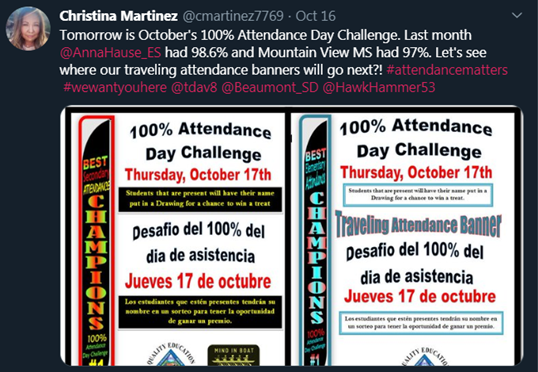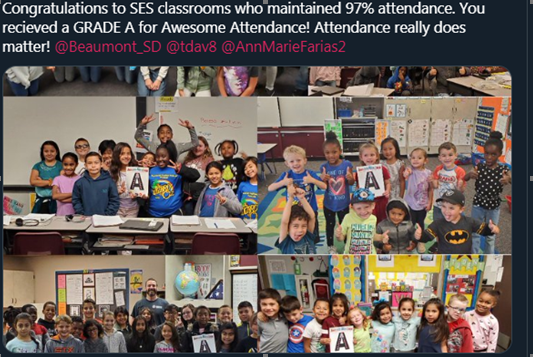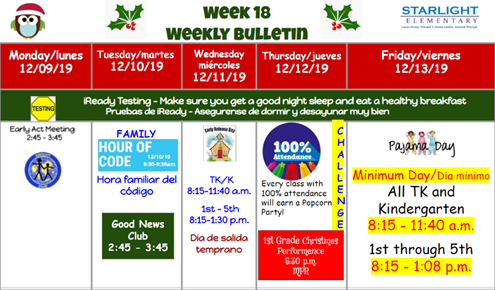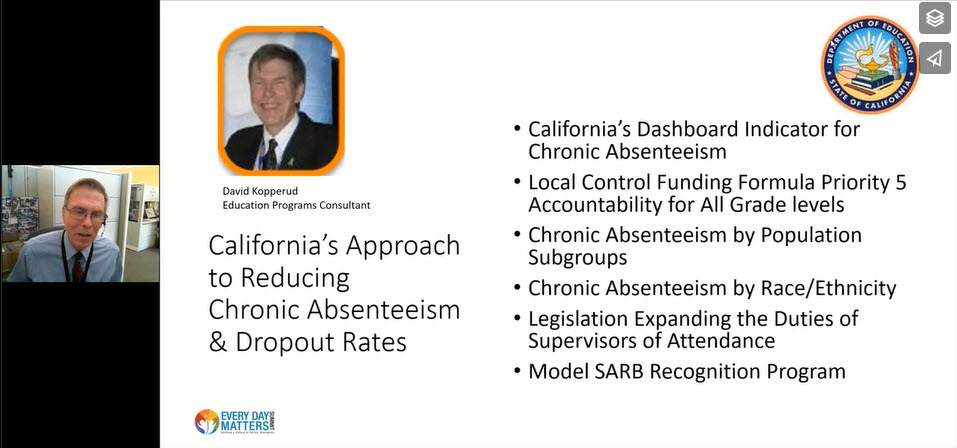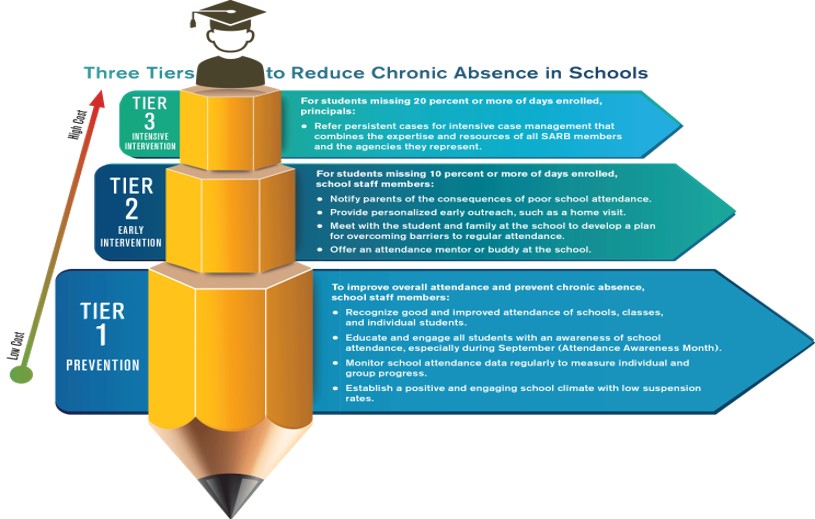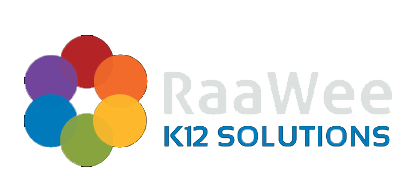Involving Campus & Community
On a broad scale, it is well accepted that community engagement is critical for school progress and reform and Strategies for Community Engagement in School Turnaround (School Network Reform, 2014) provides us best practices. Attendance Works shows how important it is to Engage Community Stakeholders in Promoting Attendance and provides inspiring examples specific to Attendance Awareness.
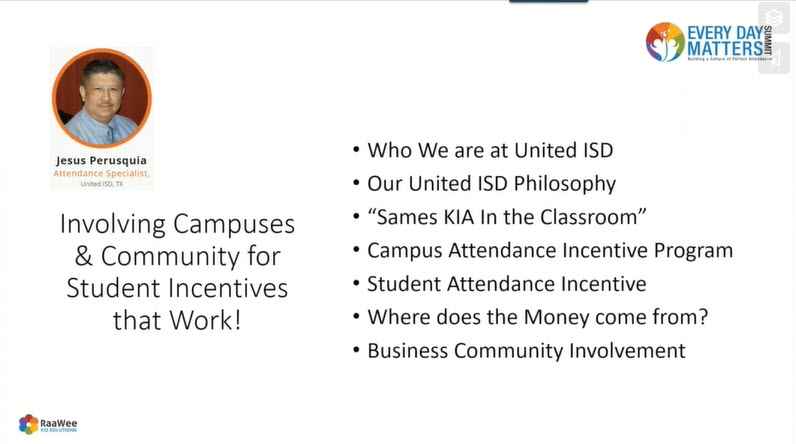
We add United Independent School District (UISD) to those districts worth replicating. UISD shares its successful programs with education leaders at the RaaWee K12 Every Day Matters Summit, November 15, 2019. View this entire best practices session at Involving Campuses & Community for Student Incentives that Work at United ISD – Every Day Matters Summit 11.15.2019.
About UISD
United Independent School District in Laredo, TX – serving the cities of Laredo, El Cenizo and Rio Bravo, and various discrete regions in Webb County – has built a comprehensive program set that draws benefits and success from both by highly engaging the community in the pizza, donuts, and ice cream parties or other “treat-like incentives,” as well as other larger prize opportunities for long-term attendance goals.

This allows local business leaders to play an active role in the success of their future employees and customers and students to build relationships and confidence outside the classroom.
Developing Attendance Awareness
In support of the fundamental premise that the success of their students is highly dependent on each student’s daily school attendance, UISD has built a powerful model for engaging their community in scalable programs that provide fun incentives for classrooms at all campuses and meaningful grade-appropriate recognition, starting in the early grades and continuing through a power prize opportunity for those students who have met the attendance requirements up to graduation day. The overall program set does a wonderful job of tying short-term rewards and recognition (building good attendance habits early) to long-term opportunities. Their Every Day Counts, Never Be Absent, and Kia in the Klassroom programs are examples of this.
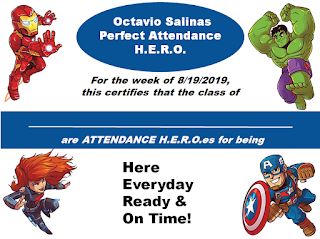
With Every Day Counts, UISD elementary and middle school students, strive to attain perfect attendance by classroom in each of the district’s six week grading periods, making them eligible to win fun prizes at their respective campuses. Awareness for these is built with posters, many made by the students, and rewarded with treats sponsored by local businesses. Check out these examples.
Individual classrooms and students attaining perfect attendance – no excused or unexcused absences up to that point in all classes – at UISD elementary or middle school receive Recognition Certificates and are eligible for the grand prize drawings at their campus. These include:
- 1st Six Weeks: 4 bikes per campus (Elem/Middle)
- 2nd & 6th Six Weeks: ChromeBook (Elem/Middle)
- 3rd & 5th Six Weeks: X-box (Elem/Middle)
- 4th Six Weeks: 4 bikes per Campus (Elem), Beats Solo Wireless Headphones (Middle)

High school students at UISD qualify for additional perfect attendance incentives, under the Never Be Absent program. Students who have maintained perfect attendance have a chance to be their high school’s winner of an all-expense-paid weekend getaway for a family of four to JW Marriott San Antonio Hill Country Resort & Spa with season passes to Fiesta Texas and movie passes to Santikos Palladium IMAX.
Special Year-End Attendance Program
The prestigious year-end Sames Kia in the Klassroom program provides one lucky high school student who wins a drawing with a brand new Kia Soul car. Students earn drawing chances by maintaining perfect attendance in each 9-week period. Students can earn up to 4 vouchers/chances at the end of the school year drawing. The Sames Kia in the Klassroom car give-a-way program is made real by the long-time sponsorship of the local Sames Kia Dealership. And to add amazing additional value, Laredo Federal Credit Union pays taxes & license fees and A&K Driving School includes their driving course to complete this comprehensive package for this lucky student with perfect attendance.

Funding The Programs
The key question “How are these programs funded?” arises immediately. For UISD, the answer is by engaging the community, a community that eagerly participates because they understand the importance. Asking for participation and donation – small and large – is a regular activity for UISD. Check out this example of a typical request, they have recently used. This Donation Request Letter represents key elements recommended in two great resources for writing your own – How to Write an Efficient Donation Request Letter – A Research Guide or How-To Write a Donation Request Letter.
For more information on these programs and all that United Independent School District does to reach and maintain their Attendance Goals for each student district-wide, check out our Every Day Matter Summit presentation by Jesse Perusquia Jr., Attendance Specialist for UISD.

About the Presenter
Jesse Perusquia Jr., Attendance Specialist, United ISD, TX
Jesse Perusquia Jr. is an Attendance Specialist at United Independent School District (UISD), where he is dedicated to promoting student attendance and engagement. With a focus on fostering positive relationships between students, families, and the school community, Jesse works diligently to implement strategies that improve attendance rates and support student success.
In his role, Jesse collaborates with educators and administrators to identify challenges affecting attendance and develop effective interventions. His commitment to creating a supportive educational environment helps ensure that all students have the opportunity to thrive.
For inquiries, Jesse can be reached at 956-473-6281 or via email at jperusquia@uisd.net.



